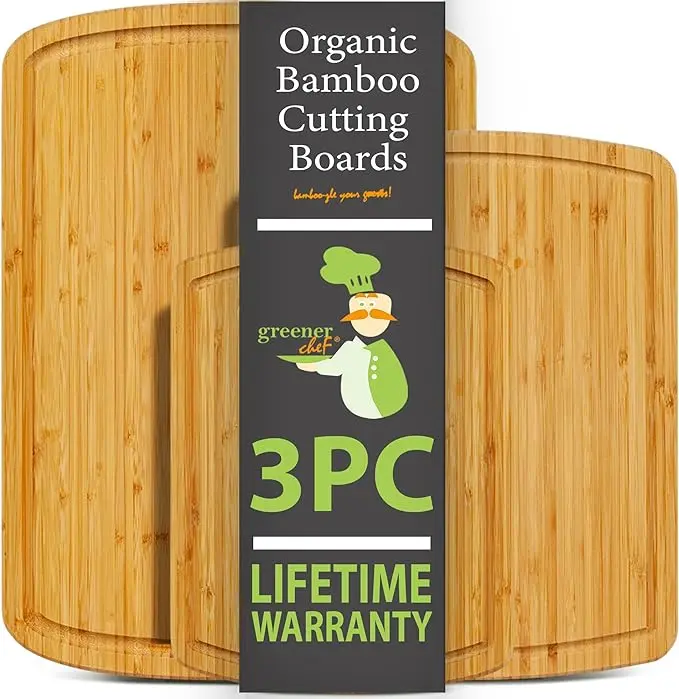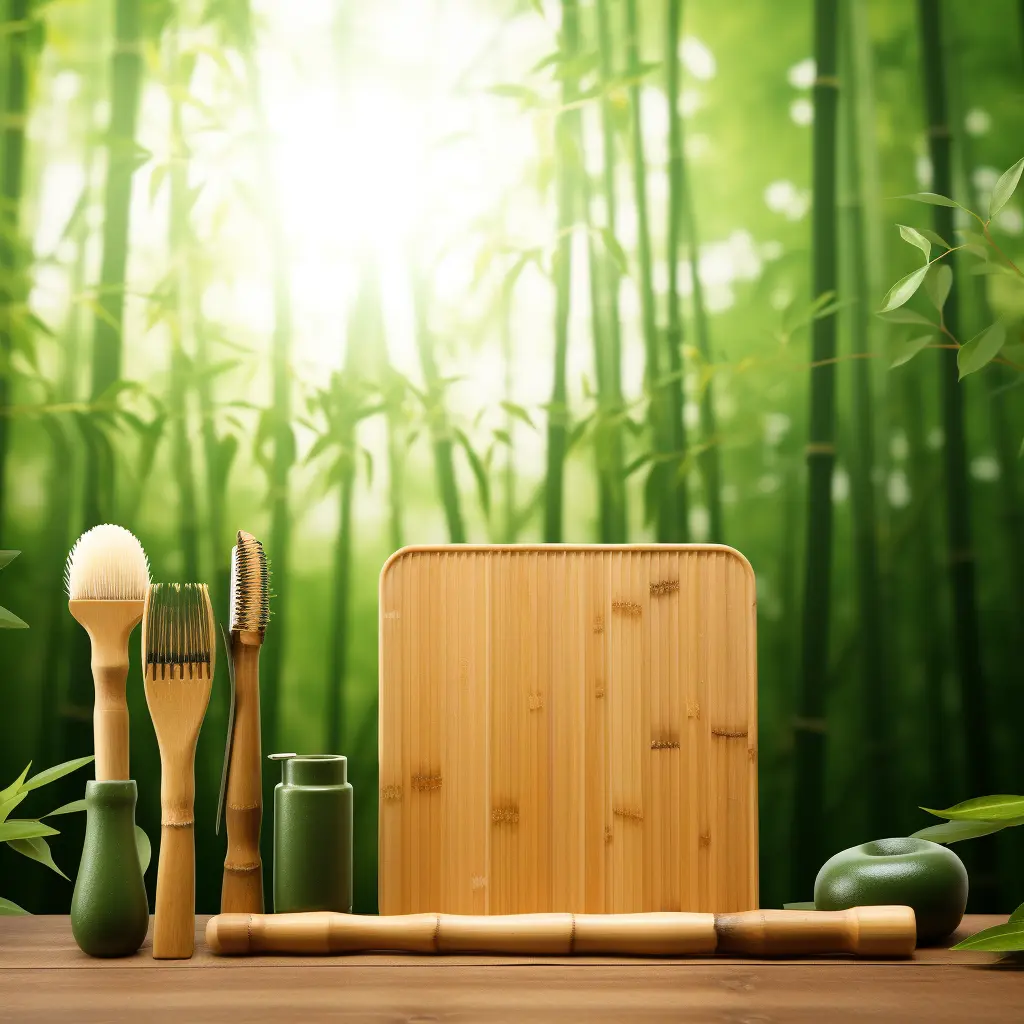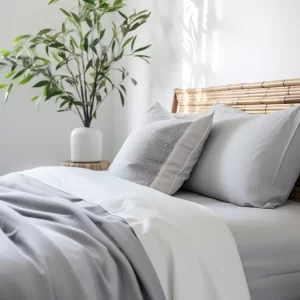How to Care for a Bamboo Cutting Board
Let’s learn how to care for your bamboo cutting board! Bamboo cutting boards offer a sustainable, attractive, and durable option for meal preparation. As consumer interest grows regarding environmentally conscious kitchen products, bamboo rises to the 🌱top of the list🌱. This fast-growing grass thrives without pesticides and regenerates quickly when harvested responsibly.
The smooth, rich grains of a bamboo cutting board practically glow 😍 in contrast to other materials. Their knife-friendly hardness also withstands years of slicing ✂️ and dicing. With proper care, these boards last over a decade, avoiding waste from worn out plastic or wood boards. Plus, their antimicrobial properties naturally resist bacteria. 🦠
Simply put, bamboo cutting boards provide an eco-friendly workhorse 💪 for the busiest kitchens. Let’s discover proper techniques for protecting their enduring beauty and performance. This guide outlines the secrets of bamboo cutting board success – read on to upgrade your countertop sustainably. 👍🌱
Table of Contents
10 Reasons to Choose a Bamboo Cutting board
- Sustainable Choice: Bamboo cutting boards are an excellent eco-friendly option. Their rapid growth rate and minimal resource requirements make them a more sustainable choice compared to traditional wood or plastic boards.
- Durability and Longevity: With proper maintenance, these boards can last over a decade, outperforming many other materials in terms of longevity. They are resistant to knife marks and less prone to warping.
- Antimicrobial Properties: The natural antimicrobial properties of bamboo help in resisting bacteria and keeping your food preparation safe and hygienic.
- Ease of Maintenance: Bamboo cutting boards are surprisingly easy to maintain. Regular cleaning with mild soap and warm water, avoiding soaking, and periodic oiling are key to their care.
- Aesthetic Appeal: These boards are not just functional but also aesthetically pleasing. Their rich, natural grain patterns add a touch of elegance to any kitchen.
- Knife-Friendly Surface: The hardness of bamboo is gentle on knives, helping to keep them sharp longer than harder cutting board materials.
- Advanced Cleaning Techniques: For deep cleaning and disinfection, methods such as salt and lemon scrubs or a hydrogen peroxide solution can be effectively used.
- Proper Storage and Use: To extend the life of your bamboo cutting board, store it properly in a cool, dry place and use it appropriately to avoid damage and warping.
- Cost-Effective: Bamboo cutting boards offer great value for money considering their durability, ease of maintenance, and the benefits they bring to both your kitchen and the environment.
- End-of-Life Sustainability: At the end of their long life, bamboo cutting boards can be composted, contributing to a zero-waste lifestyle and further emphasizing their eco-friendly advantage.
There are probably more, but these are the big ones on our list and the reason we choose bamboo cutting boards in our household! Here’s the bamboo cutting boards we use in our house:
Bamboo Brilliance: Essential Guide to Bamboo Cutting Board Care
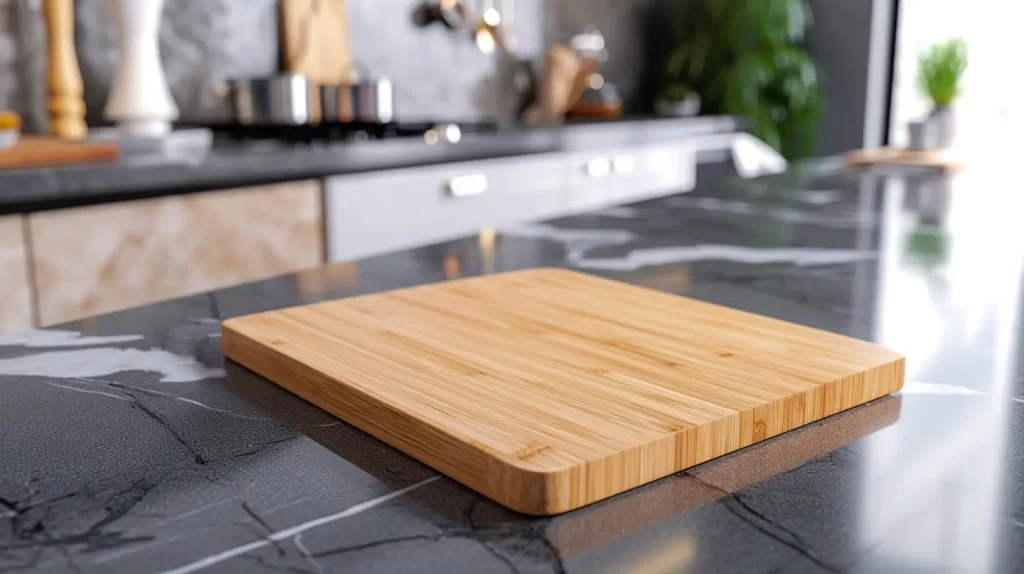
Bamboo cutting boards require some periodic care to keep them looking pristine and performing at their best. Follow this checklist to unlock their enduring brilliance:
- Clean thoroughly after each use 🧽 – Use mild soap and warm water to remove food bits. Avoid soaking or dishwashing which can warp boards.
- Dry completely 🧺 – Utilize a towel or air drying to prevent moisture damage. Warped or cracked boards lose functionality.
- Apply mineral oil regularly 🛢️ – Moisturize the surface to prevent drying out and maintain the gorgeous bamboo grain patterns.
- Store properly 📦 – Lay flat or upright in a cool, dry spot. Don’t stack heavy items on top that could dent these delicate boards.
Following these simple brilliance-boosting steps allows your bamboo cutting board to shine on for over a decade. Watch its smooth surface and carved edges maintain their graceful style with proper care. Lets dive deeper into each area to truly unlock bamboo’s magical endurance. Let’s dig in a little more!
Introduction to Bamboo Cutting Boards
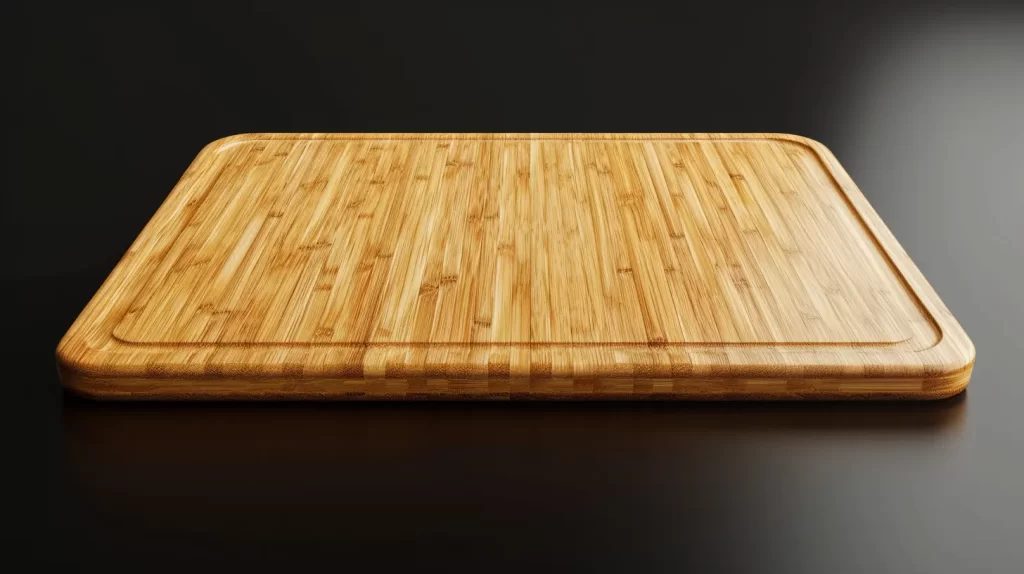
Bamboo cutting boards offer a sustainable kitchen upgrade that outperforms with antimicrobial strength. It is important to learn how to care for a bamboo cutting board. Their smooth surfaces simply work – protecting knives from dulling while resisting bacteria buildup. Just look at these winning attributes:
- Eco-Excellence 🌳 From rapid growth to responsible harvesting, bamboo defines renewable resources. Choose it for guilt-free cutting.
- Everlasting Endurance ⏳ Pound away without signs of wear. Bamboo’s legendary toughness drives decades of use.
- Knife-Kind Care 🗡️ Gentle, tight grains hone edges instead of blunting blade sharpness over time.
- Bacteria Buster 🦠 Natural antimicrobial abilities zap 99% more germs than plastic competitors.
- Culinary Creative Canvas 👩🍳 Lightweight yet durable, bamboo suits all cooking prepping needs from meats to fruits and everything between.
With these unbeatable advantages, bamboo cutting boards deliver sustainable performance other materials simply can’t match. Dive in to discover how these eco-excelling kitchen helpers unlock decades of service with antimicrobial strength.
Simple Steps to Clean a Bamboo Cutting Board
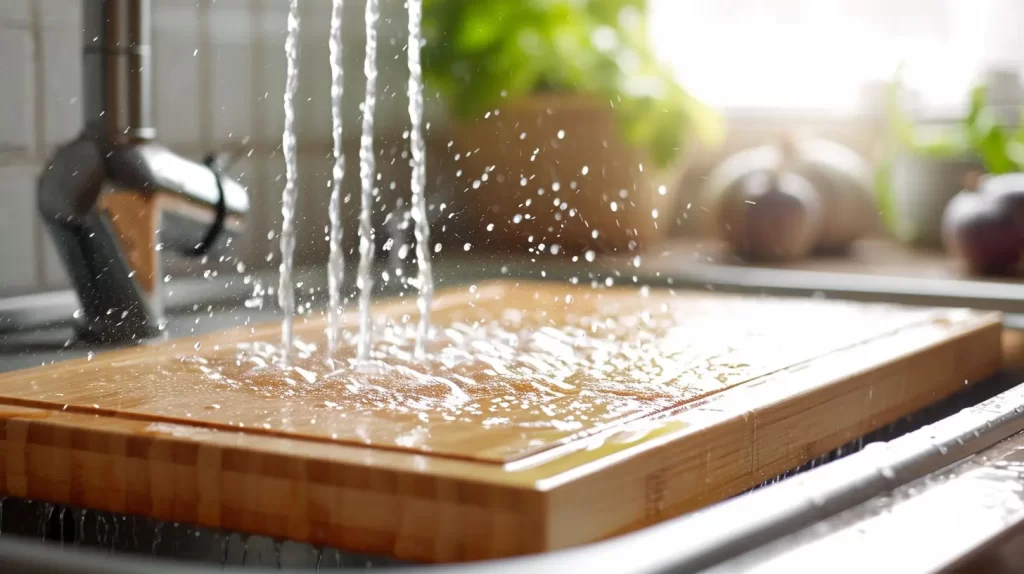
Maintaining a sparkling clean bamboo cutting board takes just minutes a day. Simply rise, wipe, and dry thoroughly after each use.
Quick Clean Routine
Bamboo requires regular upkeep to maintain its singular splendor and precision performance. An easy, fast cleaning routine lifts debris while refreshing the board’s smooth surface for continued slicing and dicing duties. By quickly rinsing, washing, and drying after each use, we prevent permanent stains and warping damage from setting in.
- Rinse 🚰 – Wash away debris under warm running water. Prevent particle drying.
- Wash 🧽 – Use gentle soap and a soft sponge to lift bits. Avoid abrasives.
- Rinse 🚰 – Check for total soap residue removal. Lingering cleaner ruins taste.
- Dry 🧺 – Absorb moisture then set upright to air dry completely.
- Don’t Soak 🚫💦 – Immersion causes irreparable board warping and cracking.
Dedicate just a few minutes to this efficient bamboo restoration routine after each use. Quick cleaning maintains the board’s brilliance and precision cutting performance day after day. With this easy upkeep process, bamboo maintains its sustainable beauty and utility for years of service.
Proper Drying
Meticulous drying is imperative for bamboo products to prevent irreversible damage from moisture. By promptly addressing residual wetness after cleaning, we allow bamboo to dry evenly, limiting cracks and warps. Dedicated drying steps enable airflow circulation to carry away lingering dampness. Correct techniques prevent distortion, maintain quality, and extend usable lifespans.
Drying correctly maintains board quality and prevents damage. Here’s how:
- Blot Dry First 🧻 – Remove excess moisture with a clean cloth first.
- Prop Upright 🪑 – Prop upright to enable air circulation all around.
- Use a Dry Towel 🧺 – Alternatively, place on a dry towel in a well-ventilated area.
- Don’t Stack Wet 🚫☝️ – Never stack wet boards or put them in the dishwasher.
By promptly addressing residual moisture, these specialized drying techniques preserve bamboo’s singular resilience and luster. Prioritizing proper airflow circulation maintains structural integrity and quality for over a decade of enduring performance. Dedicate the effort to dry properly, and enjoy bamboo’s sustainable elegance and brilliance for years to come.
Tips and Tricks for Regular Maintenance
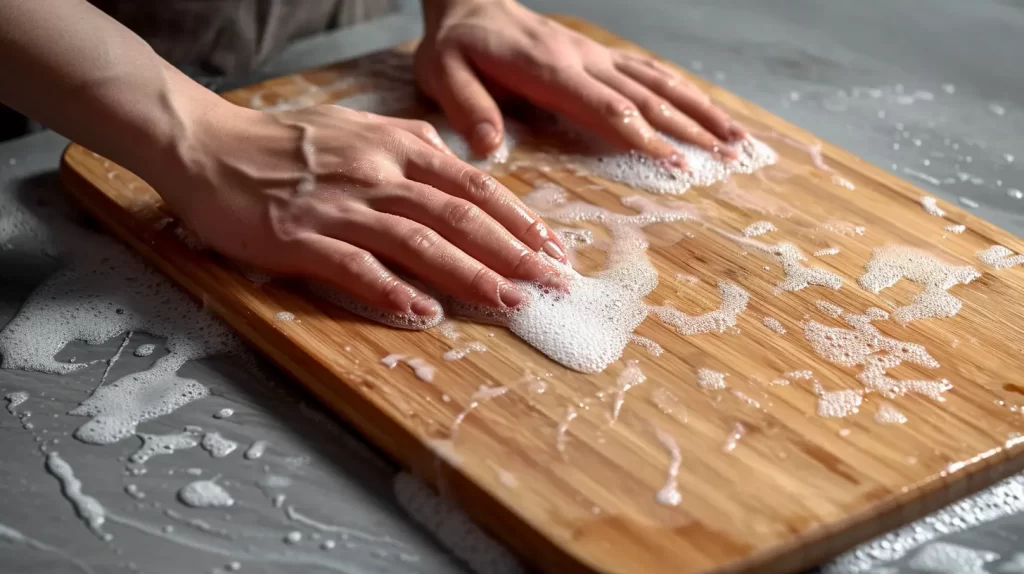
Protecting a bamboo cutting board’s beauty and performance comes down to moisture and protection. Follow these best practice guidelines for keeping boards looking pristine.
Mineral Oil for Protection
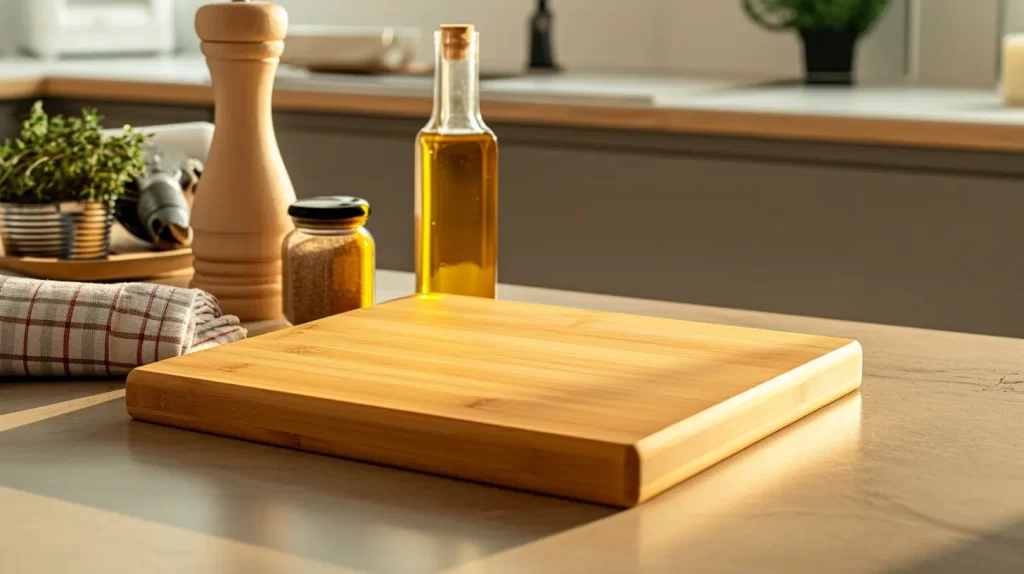
Treating a bamboo cutting board with mineral oil is important for several reasons. First, it helps maintain the board’s moisture content, preventing drying and cracking, which can occur in the naturally porous material. Second, the oil creates a protective barrier on the surface, reducing the absorption of food particles and liquids, thereby inhibiting bacterial growth. Lastly, regular oiling preserves the aesthetic appeal of the bamboo, keeping its surface smooth and enhancing its natural grain, which contributes to the board’s longevity and overall appearance.
- Choose food-safe oils 🛢️ – Mineral oil moisturizes safely. Other types breed bacteria.
- Clean thoroughly first 🧽 – Debris blocks absorption into the bamboo grain.
- Apply oil evenly 🖌️ – Pour a small amount and spread with a cloth or paper towel.
- Let penetrate 15-20 minutes ⏱️ – This allows full absorption to nourish the board.
- Wipe away excess 🧻 – Prevent stickiness and bacteria growth with a quick wipe down.
Why mineral oil?
- ✅ Moisture Retention: Wood is naturally porous and can dry out over time. Applying mineral oil helps maintain the moisture balance in the bamboo, preventing it from drying out and cracking. This is especially important in environments where the air can be dry.
- 🧴 Non-Toxic and Food Safe: Food-grade mineral oil is safe for use on surfaces that come into contact with food. It’s a non-toxic, clear, odorless oil that won’t spoil or transmit any taste or odor to the food prepared on the board.
- 🦠 Prevents Bacteria Growth: By filling in the pores and creating a barrier on the surface of the cutting board, mineral oil can help prevent water and food particles from penetrating the wood, which in turn helps inhibit the growth of bacteria.
- 💅 Enhances Appearance: Regular oiling keeps bamboo cutting boards looking new, preserving the rich color and natural grain of the wood. It can also help prevent staining from food items.
- 🕑 Easy to Apply: Mineral oil is easy to apply. Typically, you would clean and dry the cutting board, then apply a small amount of oil and rub it in with a cloth or paper towel, ensuring even coverage. Let the oil penetrate the wood for a few hours or overnight before wiping off any excess.
Prevent Warping
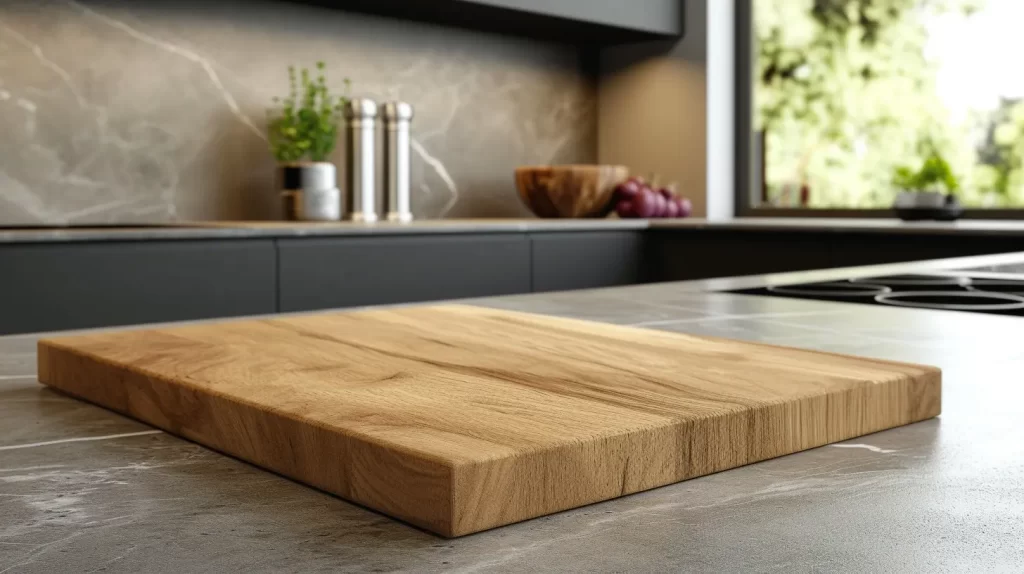
While less prone to warping than wood, bamboo boards still require proactive care to retain their signature flatness. By taking measures to limit moisture penetration and distortion, we can prevent the cracks and structural damage associated with warping. Following specialized guidelines for use, cleaning, drying, and storage allows us to tap into bamboo’s resilient nature and guard against deterioration.
Bamboo cutting boards are generally less prone to warping than wood cutting boards, but they can still warp if not cared for properly:
- Use appropriately sized boards 🪓 – Overhang leads to cracks while undersized boards slide dangerously.
- Clean and dry thoroughly 🧽🧺 – Trapped moisture causes swelling and shrinkage that distorts boards.
- Don’t soak 🚫💦 – Immersion breeds irreparable warping and cracking.
- Store properly 🗄️- storing a cool dry place, away from sunlight.
By tailoring practices to accommodate bamboo’s distinctive vulnerabilities, we reinforce its unparalleled resilience and beauty. Adhering to these specialized care guidelines preserves the enduring brilliance and performance of your bamboo board for over a decade. Be proactive against warping, and enjoy stable, sustainable elegance.
Inspecting and Refurbishing Your Bamboo Cutting Board
In addition to regular cleaning and oiling, periodic inspection and minor refurbishment play a crucial role in extending the lifespan of your bamboo cutting board. Over time, the surface of your board may show signs of wear, such as scratches, knife marks, or rough patches. Here’s how to keep it in top condition:
- Regular Inspection 🔍: Once a month, examine your board closely for any signs of splintering, deep cuts, or rough areas. These imperfections can harbor bacteria and make your cutting surface uneven.
- Gentle Sanding 🪵📜: If you find rough spots or minor damage, lightly sand the area with fine-grit sandpaper. Be sure to sand evenly to maintain a flat surface. This process smooths out imperfections and prepares the board for re-oiling.
- Re-Oiling After Sanding 🛢️💧: After sanding, clean the board to remove any wood dust and then re-apply food-safe mineral oil. This will restore the protective layer and keep the bamboo hydrated.
By incorporating this inspection and refurbishment step into your bamboo cutting board care routine, you ensure that your board remains safe, hygienic, and enjoyable to use for years to come.
Seasoning or Curing Your Bamboo Cutting Board
To ensure your bamboo cutting board remains durable and resistant to moisture, it’s important to properly season or cure it, especially when it’s new. You need to learn how to season a bamboo cutting board to make sure you get off on the right foot. This process helps to create a protective barrier that keeps the board in optimal condition. Follow these steps for effective seasoning:
- Clean the Board 🧼: Start with a clean cutting board. Wash it with mild soap and warm water, rinse thoroughly, and let it dry completely.
- Warm the Board 🌞: Slightly warm the board by placing it in a warm area or using a hair dryer. This helps open the pores of the bamboo, making it more receptive to the oil.
- Apply Oil 🛢️: Use a food-safe mineral oil or a bamboo conditioning oil. Apply a generous amount of oil evenly over the entire surface of the board, including the sides and edges.
- Let it Soak ⏳: Allow the oil to soak into the board for several hours, or ideally, overnight. This gives the bamboo fibers enough time to fully absorb the oil.
- Wipe Off Excess Oil 🧻: After the oil has been absorbed, use a clean, dry cloth to wipe off any excess oil, leaving the surface smooth and shiny.
- Repeat if Necessary 🔁: If your cutting board is brand new, it might be necessary to repeat this process a few times until it no longer absorbs the oil.
By seasoning or curing a bamboo cutting board, you’re not only protecting it from moisture and bacteria but also enhancing its durability and longevity. This initial investment of time and care sets the foundation for maintaining your bamboo cutting board’s quality over time.
Advanced Cleaning and Disinfection

To deeply clean and disinfect bamboo cutting boards, use a solution of hydrogen peroxide for its effective, non-toxic sanitizing properties. For stubborn stains and odors, apply a paste of baking soda and water, gently scrubbing it in. Regularly wiping the board with a diluted vinegar solution can also help maintain its cleanliness and disinfect the surface without damaging the bamboo.
Deep Cleaning
Deep cleaning techniques like using hydrogen peroxide or a vinegar soak enhance the antibacterial properties of bamboo cutting boards by effectively killing germs and bacteria that might not be removed by regular washing. These methods complement bamboo’s natural antimicrobial abilities, ensuring a thoroughly sanitized surface for safe food preparation.
- Salt-Lemon Rub 🍋⚗️ – An abrasive yet citrus fresh scrub that rejuvenates.
- Hydrogen Peroxide 🧪 – Bubbles lift debris even from deep grooves.
- Baking Soda Paste 🧁 – Gently polishes away stubborn gunk.
- Vinegar Soak 🥣 – An antimicrobial dip for thorough refreshment.
- Diluted Bleach 🧴 – Disinfects without risk to you or board integrity.
Rinse completely after using any treatment to prevent residue buildup.
Sanitizing Solutions
The sanitizing solutions of vinegar mixed with hydrogen peroxide, and lemon juice combined with salt, provide a natural and effective way to boost the antibacterial properties of bamboo cutting boards. These combinations work synergistically to eliminate more germs and bacteria, reinforcing the board’s inherent antimicrobial nature and ensuring a higher level of hygiene for food preparation.
- Vinegar + Hydrogen Peroxide 🥣 + 🧪 – Germ-eliminating spray, then wipe clean.
- Lemon Juice + Salt 🍋 + ⚗️ – Harnesses citric acid and gentle scouring.
- Hydrogen Peroxide + Water 🧪 + 💧 – More intensity to obliterate germs.
Disinfection gives peace of mind that the board is completely safe for cutting tasks again.
Pro Tips for Long-Lasting Care
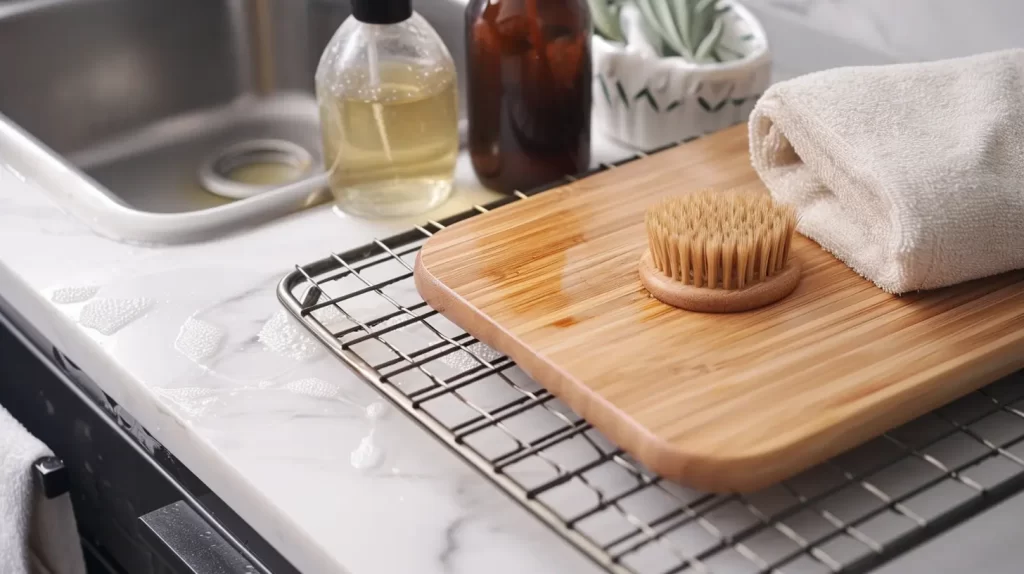
Ensuring the longevity and beauty of your bamboo cutting board doesn’t have to be complicated. From specific cleaning techniques to little-known maintenance secrets, these pro tips will empower you to provide the best possible care for your eco-friendly kitchen essential, making it a durable and reliable partner in your culinary adventures.
Unique Bamboo Needs
As a rapidly renewable, sustainable material, bamboo has unique properties that require specialized care. Unlike wood which can handle moisture, or plastic that resists stains, bamboo has specific vulnerabilities that must be properly addressed. By tailoring best practices to accommodate bamboo’s distinctive grain and texture, we can maintain its unparalleled beauty and longevity.
- No soaking 🚫💦 – Absorbs moisture leading to cracks and warps.
- Apply food-safe oils 🛢️ – Nourishes and protects the gorgeous grain.
- Limit heat exposure 🔥❌ – Prevents discoloration and surface damage.
- Use only mild soaps 🧴 – Harsh cleaners strip protective oils.
- Proper storage 🗄️ – Ventilation prevents moisture damage.
As a versatile, rapidly renewable material, properly caring for bamboo pays dividends in durability and aesthetics. By adjusting cleaning practices and storage considerations for its distinctive properties, bamboo will showcase its unparalleled beauty for years to come. Learn how to store a bamboo cutting board and treat bamboo according to its specialized needs, and it will continue providing sustainable benefits with its signature strength and elegance.
Hand Wash with Care
Bamboo requires a delicate yet thorough cleaning regimen to maintain its beauty. Hand washing bamboo allows specialized care of this sustainable material while targeting spots prone to bacteria. By following these gentle but attentive steps, we can lift debris and eliminate microbes without damaging bamboo’s distinctive grain.
Wash by hand with these specialty steps:
- Use Mild Soap 🧼 – Use mild soap and warm water.
- Target Debris 🎯 – Target food bits and stains on surfaces.
- Scrub Hot Spots 🌡️ – Focus on edges and corners – bacteria hot spots.
- Gentle Scrubbing 🖌️ – Gently scrub with soft-bristle brushes.
- Rinse and Dry 🚰🧻 – Rinse and pat completely dry.
- No Extended Soaks 🚫💦 – Avoid extended soaking.
A gentle hand washing regimen preserves bamboo’s singular splendor. By targeting stubborn spots with specialized tools and techniques, we lift stains and debris without dulling bamboo’s distinctive grain. Follow these attentive steps to maintain the enduring beauty of this sustainable material.
Conclusion and Eco-Friendly Considerations
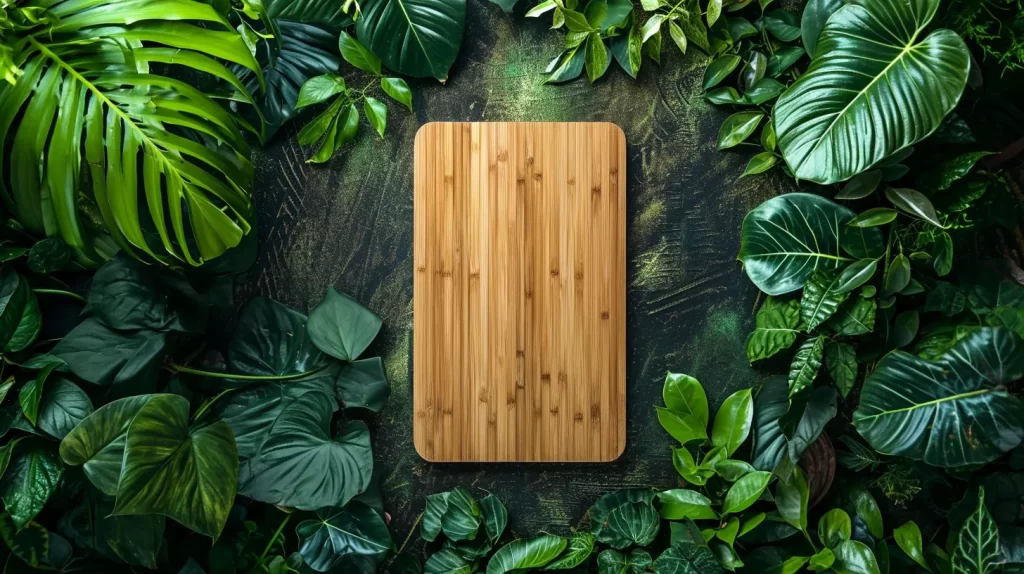
Bamboo cutting boards have several appealing qualities. They are durable, attractive, and more environmentally friendly than some alternatives. With proper care, a bamboo board can serve as a functional and hygienic surface in your kitchen for a long time. The key is to wash it thoroughly after each use, oil it periodically with food-safe oil, avoid soaking it in water for long periods, and protect it from high heat. Following basic care guidelines will help a quality bamboo cutting board age gracefully while continuing to assist food preparation tasks. Consider matching the sustainability benefits with utility and aesthetics for your kitchen.
- 🌱 Eco-Friendly: Bamboo’s rapid growth and minimal environmental impact make it a sustainable choice.
- 🛡️ Durability: With proper care, these boards are long-lasting, resisting knife marks and warping.
- 🦠 Antimicrobial: Bamboo’s natural resistance to bacteria keeps your food prep safe and hygienic.
- 🧼 Easy Maintenance: Regular cleaning with mild soap and water, and periodic oiling, keeps it in top condition.
- 👁️ Aesthetic Appeal: The natural grain pattern of bamboo adds elegance to any kitchen setting.
- 🔪 Knife-Friendly: Gentle on knives, bamboo helps maintain their sharpness for longer periods.
- 🧽 Advanced Cleaning: Techniques like salt and lemon scrubs or hydrogen peroxide solutions ensure deep cleaning.
- 🗄️ Proper Storage: Keeping the board in a cool, dry place extends its lifespan.
- 💰 Cost-Effective: Bamboo cutting boards are a practical, long-term investment for your kitchen.
- ♻️ Compostable End-of-Life: These boards can be composted, aligning with zero-waste goals.
Caring for a bamboo cutting board demonstrates good kitchen practices. Proper maintenance not only keeps the board in good condition for ongoing use, but also honors the sustainable bamboo material. By periodically applying food-safe oil, avoiding extensive soaking and high heat exposure, and cleaning thoroughly after preparation, the useful life of a bamboo board can be extended. Embracing simple care steps allows a cutting board made of renewable bamboo to contribute to food preparation tasks for years. Following guidelines to care for equipment represents a commitment to sustainability and quality results in the kitchen.

Bamboo FAQ
Q: What’s the best way to clean my bamboo cutting board?
A: For thorough cleaning, use warm water and gentle soap after each use. Gently scrub with a soft brush or sponge, then rinse very well. Allow your board to air dry upright before putting it away to prevent warping. This keeps it fresh and hygienic.
Q: Should I ever soak my bamboo cutting board?
A: It’s best to avoid soaking your bamboo board. The wooden material can warp and crack when saturated with water for too long. Quick cleaning and thorough drying is safest.
Q: What’s the benefit of oiling my cutting board?
A: Applying a food-grade mineral oil regularly nourishes the bamboo wood, keeping it beautiful and durable for all your slicing and chopping tasks. About once a month is ideal.
Q: Can I pop my bamboo board into the dishwasher?
A: It’s not recommended. The high heat levels combined with a long wash cycle can cause bamboo boards to crack and warp over time. Gentle hand washing preserves its integrity.
Q: How often does my bamboo board need a nourishing oil treatment?
A: A monthly oiling helps the bamboo stay strong and handsome. But if you notice light cracks or dry patches, it wouldn’t hurt to treat it more often. A well-oiled board wears gracefully!
Q: Is bamboo safe for cutting raw meats?
A: Bamboo’s tight grain makes it very sanitary for raw meats. Be sure to thoroughly wash and sanitize afterward so other foods don’t pick up microbes. Keeping your various food prep tasks on separate boards heightens kitchen safety.
Q: How should I store my bamboo cutting board?
A: Stand it upright in a cookbook rack or leaning against the wall to allow air circulation on both sides. This prevents moisture from being trapped and warping the wood over time.
Q: What’s your top care tip for bamboo boards?
A: The #1 habit is letting it properly air dry after every wash before putting it away. Dryness preserves the strength and integrity of the material for longevity.
Q: How can I freshen up and remove stains from my bamboo?
A: For odor removal, sprinkle some baking soda and scrub with a damp brush. For stubborn stains, massage with a baking soda paste. And for extra disinfecting power, rub a cut lemon half over the surface once in awhile.

